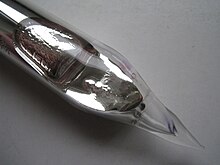 | |||||||||||||||||||||||||||||||||||||||||||||||||||
| Rubidium | |||||||||||||||||||||||||||||||||||||||||||||||||||
|---|---|---|---|---|---|---|---|---|---|---|---|---|---|---|---|---|---|---|---|---|---|---|---|---|---|---|---|---|---|---|---|---|---|---|---|---|---|---|---|---|---|---|---|---|---|---|---|---|---|---|---|
| Pronunciation | /ruːˈbɪdiəm/ | ||||||||||||||||||||||||||||||||||||||||||||||||||
| Appearance | grey white | ||||||||||||||||||||||||||||||||||||||||||||||||||
| Standard atomic weight Ar°(Rb) | |||||||||||||||||||||||||||||||||||||||||||||||||||
| Rubidium in the periodic table | |||||||||||||||||||||||||||||||||||||||||||||||||||
| |||||||||||||||||||||||||||||||||||||||||||||||||||
| Atomic number (Z) | 37 | ||||||||||||||||||||||||||||||||||||||||||||||||||
| Group | group 1: hydrogen and alkali metals | ||||||||||||||||||||||||||||||||||||||||||||||||||
| Period | period 5 | ||||||||||||||||||||||||||||||||||||||||||||||||||
| Block | s-block | ||||||||||||||||||||||||||||||||||||||||||||||||||
| Electron configuration | [Kr] 5s1 | ||||||||||||||||||||||||||||||||||||||||||||||||||
| Electrons per shell | 2, 8, 18, 8, 1 | ||||||||||||||||||||||||||||||||||||||||||||||||||
| Physical properties | |||||||||||||||||||||||||||||||||||||||||||||||||||
| Phase at STP | solid | ||||||||||||||||||||||||||||||||||||||||||||||||||
| Melting point | 312.45 K (39.30 °C, 102.74 °F) | ||||||||||||||||||||||||||||||||||||||||||||||||||
| Boiling point | 961 K (688 °C, 1270 °F) | ||||||||||||||||||||||||||||||||||||||||||||||||||
| Density (at 20° C) | 1.534 g/cm3[3] | ||||||||||||||||||||||||||||||||||||||||||||||||||
| when liquid (at m.p.) | 1.46 g/cm3 | ||||||||||||||||||||||||||||||||||||||||||||||||||
| Triple point | 312.41 K, ? kPa[4] | ||||||||||||||||||||||||||||||||||||||||||||||||||
| Critical point | 2093 K, 16 MPa (extrapolated)[4] | ||||||||||||||||||||||||||||||||||||||||||||||||||
| Heat of fusion | 2.19 kJ/mol | ||||||||||||||||||||||||||||||||||||||||||||||||||
| Heat of vaporization | 69 kJ/mol | ||||||||||||||||||||||||||||||||||||||||||||||||||
| Molar heat capacity | 31.060 J/(mol·K) | ||||||||||||||||||||||||||||||||||||||||||||||||||
Vapor pressure
| |||||||||||||||||||||||||||||||||||||||||||||||||||
| Atomic properties | |||||||||||||||||||||||||||||||||||||||||||||||||||
| Oxidation states | common: +1 −1? | ||||||||||||||||||||||||||||||||||||||||||||||||||
| Electronegativity | Pauling scale: 0.82 | ||||||||||||||||||||||||||||||||||||||||||||||||||
| Ionization energies |
| ||||||||||||||||||||||||||||||||||||||||||||||||||
| Atomic radius | empirical: 248 pm | ||||||||||||||||||||||||||||||||||||||||||||||||||
| Covalent radius | 220±9 pm | ||||||||||||||||||||||||||||||||||||||||||||||||||
| Van der Waals radius | 303 pm | ||||||||||||||||||||||||||||||||||||||||||||||||||
| Other properties | |||||||||||||||||||||||||||||||||||||||||||||||||||
| Natural occurrence | primordial | ||||||||||||||||||||||||||||||||||||||||||||||||||
| Crystal structure | body-centered cubic (bcc) (cI2) | ||||||||||||||||||||||||||||||||||||||||||||||||||
| Lattice constant | a = 569.9 pm (at 20 °C)[3] | ||||||||||||||||||||||||||||||||||||||||||||||||||
| Thermal expansion | 85.6×10−6/K (at 20 °C)[3] | ||||||||||||||||||||||||||||||||||||||||||||||||||
| Thermal conductivity | 58.2 W/(m⋅K) | ||||||||||||||||||||||||||||||||||||||||||||||||||
| Electrical resistivity | 128 nΩ⋅m (at 20 °C) | ||||||||||||||||||||||||||||||||||||||||||||||||||
| Magnetic ordering | paramagnetic[5] | ||||||||||||||||||||||||||||||||||||||||||||||||||
| Molar magnetic susceptibility | +17.0×10−6 cm3/mol (303 K)[6] | ||||||||||||||||||||||||||||||||||||||||||||||||||
| Young's modulus | 2.4 GPa | ||||||||||||||||||||||||||||||||||||||||||||||||||
| Bulk modulus | 2.5 GPa | ||||||||||||||||||||||||||||||||||||||||||||||||||
| Speed of sound thin rod | 1300 m/s (at 20 °C) | ||||||||||||||||||||||||||||||||||||||||||||||||||
| Mohs hardness | 0.3 | ||||||||||||||||||||||||||||||||||||||||||||||||||
| Brinell hardness | 0.216 MPa | ||||||||||||||||||||||||||||||||||||||||||||||||||
| CAS Number | 7440-17-7 | ||||||||||||||||||||||||||||||||||||||||||||||||||
| History | |||||||||||||||||||||||||||||||||||||||||||||||||||
| Discovery | Robert Bunsen and Gustav Kirchhoff (1861) | ||||||||||||||||||||||||||||||||||||||||||||||||||
| First isolation | George de Hevesy | ||||||||||||||||||||||||||||||||||||||||||||||||||
| Isotopes of rubidium | |||||||||||||||||||||||||||||||||||||||||||||||||||
| |||||||||||||||||||||||||||||||||||||||||||||||||||
Rubidium is a chemical element; it has symbol Rb and atomic number 37. It is a very soft, whitish-grey solid in the alkali metal group, similar to potassium and caesium.[8] Rubidium is the first alkali metal in the group to have a density higher than water. On Earth, natural rubidium comprises two isotopes: 72% is a stable isotope 85Rb, and 28% is slightly radioactive 87Rb, with a half-life of 48.8 billion years – more than three times as long as the estimated age of the universe.
German chemists Robert Bunsen and Gustav Kirchhoff discovered rubidium in 1861 by the newly developed technique, flame spectroscopy. The name comes from the Latin word rubidus, meaning deep red, the color of its emission spectrum. Rubidium's compounds have various chemical and electronic applications. Rubidium metal is easily vaporized and has a convenient spectral absorption range, making it a frequent target for laser manipulation of atoms.[9] Rubidium is not a known nutrient for any living organisms. However, rubidium ions have similar properties and the same charge as potassium ions, and are actively taken up and treated by animal cells in similar ways.
- ^ "Standard Atomic Weights: Rubidium". CIAAW. 1969.
- ^ Prohaska, Thomas; Irrgeher, Johanna; Benefield, Jacqueline; Böhlke, John K.; Chesson, Lesley A.; Coplen, Tyler B.; Ding, Tiping; Dunn, Philip J. H.; Gröning, Manfred; Holden, Norman E.; Meijer, Harro A. J. (2022-05-04). "Standard atomic weights of the elements 2021 (IUPAC Technical Report)". Pure and Applied Chemistry. doi:10.1515/pac-2019-0603. ISSN 1365-3075.
- ^ a b c Arblaster, John W. (2018). Selected Values of the Crystallographic Properties of Elements. Materials Park, Ohio: ASM International. ISBN 978-1-62708-155-9.
- ^ a b Haynes, William M., ed. (2011). CRC Handbook of Chemistry and Physics (92nd ed.). Boca Raton, FL: CRC Press. p. 4.122. ISBN 1-4398-5511-0.
- ^ Lide, D. R., ed. (2005). "Magnetic susceptibility of the elements and inorganic compounds". CRC Handbook of Chemistry and Physics (PDF) (86th ed.). Boca Raton (FL): CRC Press. ISBN 0-8493-0486-5.
- ^ Weast, Robert (1984). CRC, Handbook of Chemistry and Physics. Boca Raton, Florida: Chemical Rubber Company Publishing. pp. E110. ISBN 0-8493-0464-4.
- ^ Kondev, F. G.; Wang, M.; Huang, W. J.; Naimi, S.; Audi, G. (2021). "The NUBASE2020 evaluation of nuclear properties" (PDF). Chinese Physics C. 45 (3): 030001. doi:10.1088/1674-1137/abddae.
- ^ Lenk, Winfried; Prinz, Horst; Steinmetz, Anja (2010). "Rubidium and Rubidium Compounds". Ullmann's Encyclopedia of Industrial Chemistry. Weinheim: Wiley-VCH. doi:10.1002/14356007.a23_473.pub2. ISBN 978-3527306732.
- ^ "Rubidium (Rb)". American Elements (americanelements.com). Retrieved 2024-03-27.

